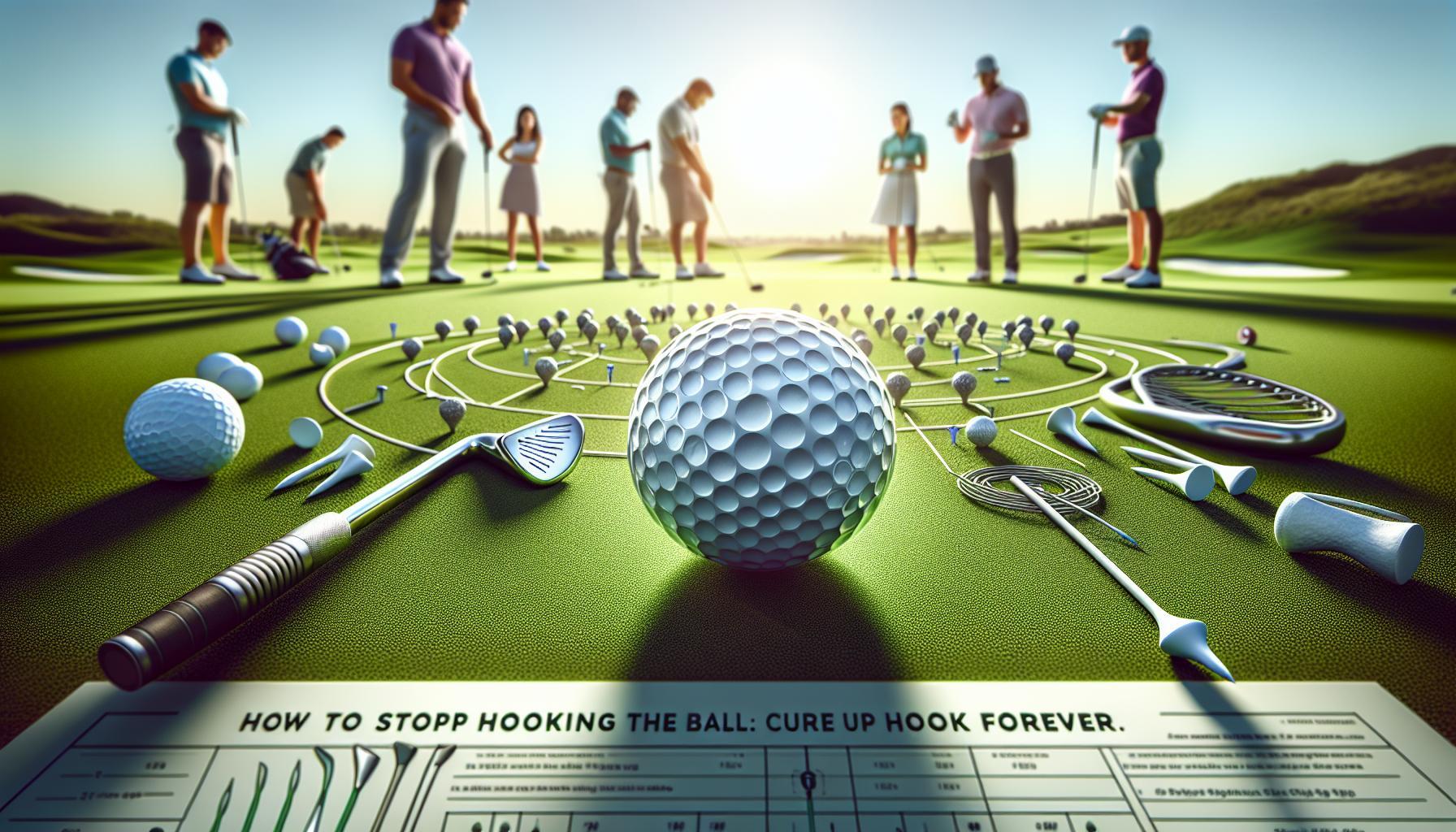Are you frustrated by consistently hooking your golf shots? This common dilemma can wreak havoc on your game, leading to lost strokes and a lack of confidence on the course. Understanding how to stop hooking the golf ball is crucial for any golfer looking to improve their accuracy and overall performance.
By diving into the mechanics of your swing and exploring effective techniques to address this issue, you’ll discover the keys to achieving a straighter, more controlled ball flight. Whether you’re a beginner or a seasoned player, the insights shared here can empower you to transform your game and enjoy your time on the course even more.
Join us as we unpack the strategies and adjustments that can help cure your hook forever, leading to a more enjoyable golfing experience and lower scores.
How a Hook Forms: Understanding the Mechanics
The mechanics behind a golf hook are often rooted in the alignment and movement of the club throughout the swing. A hook occurs when the golf ball starts to the right of the target (for a right-handed golfer) and then curves sharply left. This undesirable shot can be attributed to several key factors in your swing mechanics that, when understood, can help you eliminate the hook from your game.
One of the primary causes of a hook is the clubface position at impact. If the clubface is closed relative to the swing path, it can impart excessive right-to-left spin on the ball. This often happens when the hands are ahead of the clubhead at impact, forcing the face to rotate excessively. To visualize this, consider the position of the clubface as it strikes the ball; when it closes too much, it not only affects direction but can significantly alter the spin rate, leading to that pronounced left curve.
Another aspect is your swing path. A path that approaches the ball from an inside-out position can increase the likelihood of a hook, especially when combined with a closed clubface. An inside-out path is common among many golfers; however, if it is too pronounced, compensating corrective measures must be taken to ensure a straighter impact angle. Proper alignment and swing drills focusing on maintaining a neutral swing path can minimize this tendency.
Lastly, the grip you use significantly influences your hook. A grip that is too strong can close the clubface prematurely, resulting in a hook. Being aware of your grip pressure and adjusting your grip position can maintain the clubface’s alignment throughout the swing, thereby reducing the chance of an uncontrolled hook. Regular feedback from video analysis or instruction can offer further insights into these mechanics and ensure that corrective measures are effectively implemented in your practice sessions.
By understanding these mechanics and their interconnections-clubface position, swing path, and grip-golfers can begin to break the cycle of hooking the ball and strive toward a more consistent, straight shot.
Common Causes of a Golf Hook and How to Identify Them
Understanding the intricacies behind a golf hook can significantly enhance your game and prevent those frustrating shots that curve dramatically to the left. A hook is primarily caused by an improper combination of clubface position, swing path, and grip. Identifying these causes is the first step towards consistently hitting straight shots.
One of the most significant culprits of a hook is a closed clubface at impact. This occurs when the face of the club is pointing left of the target line at the moment of contact. A common scenario is when the hands lead the clubhead too much, causing an excessive rotation of the face. When this happens, the ball is not only struck incorrectly, but it also spins radically to the left, exacerbating the hook effect. To diagnose this issue, golfers can use video analysis tools to see where their clubface is aimed during impact. Additionally, an easy way to check is by hitting shots with alignment sticks set behind the ball – a closed face will often show clear deviations from your intended target.
Another major factor involves your swing path. For many golfers, particularly those just starting, an inside-out swing path can create opportunities for a hook. While a slightly inside-out approach can promote a draw for some players, too much of this path, combined with a closed clubface, will lead to a drastic leftward ball flight. Monitoring your swing path through practice drills, such as swinging with a half-open stance, can help improve consistency and alignment. Utilize impact tape on the clubface to observe where you’re making contact, allowing you to adjust your path accordingly.
Lastly, the grip you employ can greatly influence how likely you are to hook the ball. A grip that is overly strong-where the hands are turned too far to the right on the club (for right-handed golfers)-can easily lead to premature closure of the clubface. To determine if your grip is a factor, pay attention to your grip pressure: a lighter grip can help maintain more control over clubface alignment through the swing. Adjusting your grip style, perhaps towards a more neutral position, could immediately help in dispelling the tendency to hook.
In summary, inspecting your clubface orientation at impact, refining your swing path, and adjusting your grip can dramatically reduce the chances of a hook. Through practice, video feedback, and mindful adjustments, you can transform your shot accuracy and steer clear of this pesky flaw in your game.
Visualizing Your Swing Path: Key Techniques to Cure a Hook
Visualizing your swing path can dramatically enhance your performance on the course, especially when it comes to curing a hook. Many golfers mistakenly believe that the path of their swing is a mere afterthought; however, understanding and visualizing this critical element is essential to improving shot accuracy and consistency. By adopting certain visualization techniques, you can effectively transform how you approach your swing and eliminate the common tendency to hook the ball.
Start by imagining a clear, defined arc that represents the optimal path your club should take. A good exercise is to set up alignment sticks on the ground parallel to your target line, slightly wider than your stance. As you practice your swing, visualize the clubhead following these sticks throughout the entire motion-this will reinforce the feeling of a neutral or slightly inside-out swing path that minimizes the chances of a closed clubface at impact. Remember, a perfect swing path requires seamless coordination between your body rotation and club movement, so pay attention to your hips and shoulders as you visualize their role in guiding the club along that ideal arc.
Additionally, consider using aids like impact tape or spray on your clubface during practice. Recording your results helps you develop a mental picture of where your club is making contact with the ball and how it relates to your swing path. For instance, if your tape displays contact towards the toe or heel, it may indicate an erratic swing path. Visualizing corrections through slow-motion swings or using video analysis tools can provide insight into specific adjustments necessary to keep your club path consistent.
Incorporating imagery techniques into your practice routine will allow you to better understand the mechanics behind a successful swing. As you engage with these visualization exercises, focus on feeling the weight of the club and the movement of your body, reinforcing muscle memory that aligns with the desired path. By internalizing these visualizations, you can empower yourself to combat a hook effectively, leading to straighter shots and greater confidence on the course.
Drills to Improve Your Swing Mechanics and Eliminate Hooks
To successfully eliminate the dreaded hook from your golf game, engaging in targeted drills is essential. Understanding the mechanics of your swing and the setup can make a substantial difference in your performance. A well-rounded approach focusing on specific areas will help you refine your technique while boosting confidence on the course.
Start with the alignment drill. Set up alignment sticks or clubs on the ground parallel to your target line. Position yourself so that your feet, knees, hips, and shoulders are aligned with these sticks. This reinforces the importance of proper alignment at address. Once you are set, practice your swing ensuring that the clubhead remains on a straight path relative to your body and the alignment aids. Doing so helps in promoting a more neutral swing path which can significantly reduce the tendency to close the clubface prematurely, a common cause of hooks.
Next, incorporate the one-handed drill. This exercise isolates the two hands to help identify if one is causing the hook more than the other. Begin hitting shots with just your left hand on the club (for right-handed golfers). Focus on keeping the clubface square to the path throughout the swing. Once comfortable, switch to your right hand. This drill will not only build strength but will also allow you to feel the necessary movements without the influence of the opposite hand, leading to a deeper understanding of how each hand affects your swing mechanics.
Finally, engage in the follow-through drill. After each shot, focus on having a full follow-through where your body rotates towards the target, with the club finishing high. Completing your follow-through not only helps in achieving better distance and accuracy but also ensures that your swing path is more elongated and less likely to pinch the ball, causing it to hook. A full follow-through indicates that your weight is transitioning properly onto your front foot, which is critical in reducing hooks.
By practicing these drills consistently, you’ll strengthen your muscle memory linked to a correct swing path, helping you to overcome the hook and leading to greater accuracy and control in your game.
Equipment Considerations: Choosing the Right Golf Clubs
To tackle the challenge of hooking the golf ball, the right equipment plays a critical role in influencing your performance on the course. Golf clubs, specifically designed to enhance your swing mechanics and provide optimal control, can significantly mitigate the tendencies that lead to hooks. Selecting the correct clubs involves understanding how various technologies and specifications work together to support a more neutral ball flight.
The first consideration in your club selection should be the shaft flex. A shaft that is too flexible may lead to a closed clubface at impact, exacerbating the hook. Conversely, a shaft that is overly stiff can lead to inconsistencies in swing tempo and timing. It’s essential to find a flex that matches your swing speed-generally, a stiffer flex is better for faster swings. For most golfers, a regular flex is suitable, but players with swing speeds exceeding 100 mph may benefit from a stiff flex for better control.
Next, consider the clubhead design. Drivers and woods with a higher forgiveness design can help correct minor swing flaws. Look for clubs that feature a slightly open face angle, as these can help reduce the tendency to hook by promoting a straighter path at impact. Additionally, adjustable weights allow you to shift the center of gravity to promote a more neutral ball flight, which can be particularly beneficial for addressing overactive hands through the swing.
Additionally, when selecting irons, think about their loft and lie angle. A stronger loft can help you achieve a lower launch, which may counteract excessive hooking. However, a flatter lie angle can prevent the toe of the club from digging into the ground, keeping the face from closing abruptly at impact. Testing various loft and lie adjustments during a fitting session can provide valuable insight into what tweaks may help correct your hook.
Finally, pay attention to the grip size and texture. A correct grip size can enhance control and prevent excessive wrist movement during your swing, which is a common culprit behind hooks. Experimenting with wrap styles and textures can also affect how securely you hold the club, giving you more stability and confidence during your swing.
In conclusion, choosing the right golf clubs involves matching the equipment specifications to your individual swing characteristics and playing style. Investing in a comprehensive club fitting session with a professional can pay dividends in reducing your hooks and improving your overall performance on the course.
Grip Adjustments: Enhance Control and Reduce Hooking
A common misconception is that grip adjustments do not significantly impact a golfer’s ability to minimize hooks. However, the grip is one of the most critical elements in controlling the clubface during the swing. Proper grip size and positioning can greatly enhance your control, allowing for more consistent shots and reducing the likelihood of an unwanted hook.
To ensure you are using the appropriate grip size, consider measuring your hand size. Grips come in various diameters, and a grip that is too small can lead to increased wrist movement, promoting a closed clubface at impact. Conversely, a grip that is too large can hinder your ability to close the clubface appropriately, leading to poor clubface control. A comfortable standard grip size is typically recommended, but players with larger hands may find that an oversized grip helps provide the stability they need. When choosing a grip, also pay attention to its texture. A tacky grip material can enhance feel and control, allowing for a firmer grasp throughout your swing.
Another crucial aspect of grip adjustments is the grip pressure. Tension in your hands can have a pronounced effect on your swing mechanics, leading to hooks. Aim to maintain a light grip pressure-enough to hold the club firmly but relaxed enough to prevent tightness in your hands and forearms. A helpful drill is to use a lighter grip on the club during your practice swings and focus on achieving a smooth wrist hinge. This can help you establish a more fluid swing that reduces the chance of closing the clubface too early.
Grip Positioning
The positioning of your hands on the club can also significantly alter your tendency to hook. Experimenting with different hand placements may yield beneficial results. If you find yourself consistently hooking the ball, try rotating your hands slightly counterclockwise (for right-handed golfers) on the grip. This adjustment creates a more open clubface at address and facilitates a straighter path through impact. Conversely, if your hands are too far to the right or in a strong position, it could exacerbate the tendency to hook.
Ultimately, regular assessment and adjustments to your grip can create a notable difference in your performance. Making these minor changes may seem trivial, but they can dynamically influence your swing mechanics, providing you with enhanced control and the ability to eliminate hooks from your game. Consider investing time in practice with different grip techniques and regularly reassess grip size during club fittings to ensure you are achieving the best results possible.
Impact Factors: Understanding Face Angle and Path
Understanding the angle of the clubface at impact and the path of your swing is vital in addressing the issue of hooking the golf ball. A hook usually occurs when the clubface is closed relative to the swing path at impact, leading the ball to veer left for right-handed golfers. This specific interaction is not just a random occurrence; it’s rooted in the mechanics of how you deliver the clubhead to the ball. A critical point to note is that even a slight misalignment in the face angle can lead to significant deviations in the ball’s trajectory.
To effectively manage your face angle and swing path, several factors require your attention. First, evaluate your stance and alignment before every shot. Ensuring that your shoulders, hips, and feet are properly aligned to the target line is essential. Misalignment often leads to compensatory movements during the swing, which can close the clubface unintentionally. Maintain a straight line from your shoulders to your target and check your clubface with a practice swing. Using alignment sticks or visual markers on the ground can provide helpful visual cues to correct positioning.
Another factor to consider is the grip. A stronger grip (where the hands are rotated toward the trail side) can lead to an increased likelihood of closing the clubface at impact. Instead, a more neutral grip, where the hands are positioned in a way that neither favors an open nor closed face, may assist in achieving a square clubface at impact. Regularly practicing different grip strengths and positions allows you to find a grip that enables you to maintain optimal control over the clubface throughout the swing.
Finally, focus on your swing path. A common misconception is that a purely inside-to-out motion will correct a hook, but it’s essential to understand that the swing path must complement the face angle at impact. If your swing is excessively inside-to-out, even a square face can lead to a hook. Strive for a balanced swing plane; the clubhead should travel in a path that maintains a slight outward angle but also allows the clubface to remain square as you strike the ball. Drills that encourage a slightly steeper angle of attack at the start of your downswing can help in achieving this balance.
By closely monitoring these impact factors-face angle, grip strength, and swing path-you can make informed adjustments that reduce the propensity to hook the ball. This understanding, supported by consistent practice, can lead to a more controlled and enjoyable game.
Mental Strategies: Building Confidence to Overcome a Hook
Building confidence on the golf course is perhaps as critical as mastering your swing mechanics, especially when dealing with a persistent hook. Understanding that mental barriers can significantly influence performance allows golfers to approach their game holistically. Recognizing the psychological aspects of golf can help you transform your mindset, making your physical adjustments more effective and sustainable.
One effective mental strategy is visualization. Before you tee off, take time to imagine every aspect of your successful shot. Envision the ball arcing gracefully toward your target while you maintain a relaxed posture. By visualizing your desired outcome, you train your brain to react positively when it’s time to swing. Ensure you practice this visualization with clarity, focusing on the landscape of the hole, your stance at address, and the fluidity of your swing. With consistent practice, this technique can psychologically reinforce a more confident and positive approach during your round.
Another pivotal aspect is routine and consistency. Developing a pre-shot routine can anchor your mental state and foster confidence. This routine could include aligning your stance, taking a deep breath to release tension, and consciously setting your grip before addressing the ball. The more you practice and stick to your routine, the more it feels like second nature, reducing anxiety and helping you to focus on the execution rather than the fear of hooking the ball.
Lastly, embrace a growth mindset. Instead of viewing hooks as failures, treat them as valuable learning opportunities. Analyzing the causes of your hook without self-criticism can lead to meaningful adjustments. For example, acknowledging that a hook resulted from a closed clubface can redirect your attention to grip and alignment rather than diminishing your confidence. By reframing your experience, you can cultivate resilience, allowing you to recover from mistakes and approach each shot with renewed assurance.
Incorporating these mental strategies does not only boost overall performance but also enhances your enjoyment of the game. Golf is as much a mental challenge as it is a physical one; equipping yourself mentally to counter the inevitable hooks will lead to a more fulfilling and successful golfing experience.
Real-Life Success Stories: Turning Hooks into Straight Shots
Many golfers have faced the frustrating challenge of a persistent hook. However, there are countless success stories where players managed to turn their hooks into straight shots, often through insights gleaned from experience and a willingness to adapt. Take the case of professional golfer Tom. After struggling with his hook for multiple seasons, Tom finally sought help from a swing coach who specialized in biomechanics. Together, they identified key elements of his swing that contributed to the problem, including an overly strong grip and a closed clubface at impact. By incorporating specific drills and refining his grip pressure, Tom could stabilize his swing path and achieve straighter shots.
Another inspiring example is Sarah, an amateur golfer who found herself consistently hooking her drives off the tee. After extensive video analysis of her swing and on-course performance, she realized that her stance was closed, causing her upper body to pull away during her downswing. Committed to change, Sarah established a new pre-shot routine that included ensuring her stance was properly aligned with the target. Additionally, she dedicated time to practicing with alignment sticks during range sessions, which transformed her muscle memory. Eventually, her hooks diminished, allowing her to hit more fairways and improve her overall game.
For those struggling with a hook, consider the benefits of community support. Joining a local golf group or online forum can provide access to shared experiences and successes. Engaging with other golfers who have overcome similar challenges often opens up new strategies and tips. This communal approach not only enhances individual practice but also fosters a positive mindset, encouraging golfers to view their hooks as temporary hurdles rather than permanent flaws.
Learning from others’ journeys can empower players at all levels to tackle the complexities of their swings confidently. Whether utilizing professional coaching or engaging with fellow enthusiasts, the path to overcoming a hook becomes clearer, with many golfers proving that it’s possible to turn past struggles into a solid foundation for future success.
Expert Tips: Learning from Pro Golfers to Cure Your Hook
Many professional golfers have faced the hook at some point in their careers, learning valuable lessons that can help everyday players overcome this common issue. One of the most significant insights comes from analyzing the techniques that successful players employ to maintain a consistent swing path and improve clubface control. For example, champion golfers often emphasize the importance of a neutral grip-not too strong or weak-as it promotes better clubface alignment through impact. A neutral grip enables players to square the clubface at contact, reducing the likelihood of excessive draw or hook spin.
In addition, professionals frequently focus on the mechanics of their takeaway and downswing. Key players, such as Jordan Spieth and Rory McIlroy, highlight the necessity of a smooth, one-piece takeaway. This method ensures that the arms and body work in unison, minimizing the chances of an errant swing path that contributes to hooking the ball. By maintaining a steady tempo throughout the swing and avoiding abrupt movements at the top of the backswing, players can establish a more reliable path that promotes straight shots.
To enhance your ability to visualize the perfect swing path, consider using alignment aids during practice. Many pros recommend setting up alignment sticks on the ground or using the features of the range to line up shots correctly. This visual feedback can help reinforce the proper swing mechanics and promote greater consistency. Furthermore, maintaining a proper posture throughout the swing can allow for a more efficient motion; pro golfers often emphasize keeping their spine angle steady as they transition from backswing to downswing, allowing the club to move along the intended path without disruption.
Lastly, mental discipline is equally crucial in mastering your technique. Professional golfers often rely on routines and visualization techniques to stay calm and focused during play. Building a solid pre-shot routine that includes visualizing the desired shot trajectory can empower players to trust their swings rather than second-guessing themselves, leading to greater confidence and ultimately reducing the tendency to hook the ball. By adapting these expert tips into your practice regimen, you can transform your swing dynamics and enhance your game.
Advanced Techniques: Fine-Tuning Your Swing for Precision
Achieving precision in your golf swing requires a multifaceted approach, addressing both technical aspects and personal habits. One effective starting point is to integrate the use of video analysis into your practice sessions. Recording your swing allows you to see your mechanics in action, uncovering flaws in your posture, takeaway, and follow-through. Look for key indicators of hook formation, such as an inside-out swing path or a closed clubface at impact. By reviewing these recordings, you can make informed adjustments to promote a more neutral path.
Another advanced technique is the installation of swing aids, like alignment sticks or impact bags. These tools can reinforce proper positioning and swinging technique. For example, placing an alignment stick just outside your ball’s target line will encourage a more outgoing swing path, reducing the tendency to hook. Similarly, an impact bag can help you feel the correct angle of release at impact, emphasizing the importance of keeping the clubface square.
Consistency is further enhanced by adopting a structured practice routine that focuses on specific aspects of your swing mechanics. Consider breaking down your practice time into segments that address the grip, stance, and swing path. For instance, dedicate 10-15 minutes solely to grip adjustments, ensuring it’s not too strong, followed by concentrated efforts on core mechanics like rotation and follow-through. This step-by-step approach can solidify your muscle memory and help maintain a smooth, controlled motion.
Lastly, regularly seek feedback from a professional coach or experienced golfer who can offer insights tailored to your individual swing style. They can provide real-time adjustments and advanced drills to combat hooks effectively. For instance, drills that emphasize the horizontal shoulder turn rather than excessive arm movement can greatly improve your accuracy and reduce hooks. Utilizing these advanced techniques, alongside diligent practice, will pave the way to a more precise and controlled swing, ultimately reducing the frustrating hooks that interrupt your game.
FAQ
Q: What is the main reason golfers hook the ball?
A: The primary reason golfers hook the ball is an improper swing path combined with a closed clubface at impact. This often results from an inside-out swing with the clubface turning too much to the left for right-handed golfers. Addressing your grip and stance can help realign your swing.
Q: How can I adjust my grip to stop hooking the ball?
A: To reduce hooking, consider a weaker grip by rotating your hands counter-clockwise on the club. This adjustment minimizes the likelihood of closing the clubface at impact, promoting more consistent shots. Check the grip section in your article for detailed techniques.
Q: What drills can help me eliminate hooks from my game?
A: Effective drills include the “two-ball drill,” where you set up two balls side by side and focus on hitting the one furthest from you while maintaining a neutral swing path. Practicing this can develop better swing mechanics-detailed drills can be found in your article.
Q: How does swing path affect hooking a golf ball?
A: A golfer’s swing path significantly influences the direction and spin of the ball. An inside-out swing path generally leads to a hook if paired with a closed clubface. Visualizing and practicing proper path mechanics can help with straightening shots.
Q: What mental strategies can help overcome a hook?
A: Building confidence through positive visualization and controlled breathing can substantially help in overcoming a hook. Focus on maintaining a calm mindset during your swing, which reduces tension and promotes better mechanics as discussed in your mental strategies section.
Q: Are there specific clubs that can help reduce hooking?
A: Yes, using clubs with higher loft can help mitigate hooks by reducing the effect of closed clubface angles. Additionally, certain draw-biased drivers can assist in correcting swing paths. Consult the equipment section of your article for more detailed recommendations.
Q: When should I reassess my equipment for hooks?
A: You should consider reevaluating your equipment if you consistently hook the ball despite making swing adjustments. An improper club fit, particularly in shaft flex or length, can negatively affect your swing mechanics, making it essential to ensure your clubs complement your swing style.
Q: What are some signs I might be hooking my golf ball?
A: Signs that you might be hooking include excessive leftward movement of your shots (for right-handed players) and noticing a strong curve to the left. Frequent hooks can often be accompanied by a loss of distance and consistency, indicating areas for improvement in your technique.
The Conclusion
Now that you’ve discovered how to stop hooking the golf ball, it’s time to put this knowledge into practice and experience the game-changing difference on the course. Remember, the techniques outlined will not only correct your hook but also enhance your overall swing mechanics. Don’t wait-start implementing these tips today so you can enjoy straighter drives and improved confidence in your game.
For further improvement, consider exploring our detailed guides on perfecting your grip and alignment, or dive into how to choose the best golf ball for your swing style. Each resource is designed to amplify your success. If you have questions or insights to share, we’d love to hear them in the comments below-join the conversation and let’s connect!
Ready to elevate your game? Sign up for our newsletter to stay updated with expert tips, reviews, and more essential golf techniques designed to drive your performance forward. Hit the links with renewed confidence and tackle every round head-on!

